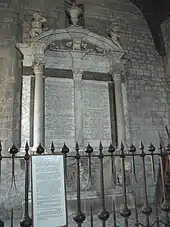Church of the Holy Trinity, Newton St Loe
The Anglican Church of the Holy Trinity in Newton St Loe within the English county of Somerset is a Grade II* listed building.[1]
| Church of the Holy Trinity | |
|---|---|
 | |
| Location | Newton St Loe, Somerset, England |
| Coordinates | 51°22′56″N 2°25′51″W |
| Built | 14th century |
Listed Building – Grade II* | |
| Designated | 1 February 1956[1] |
| Reference no. | 1129501 |
 Location of Church of the Holy Trinity in Somerset | |
A church has stood on the site, close to Newton St Loe Castle and Newton Park, since the 11th century, however the current stone building was constructed in the 14th with the tower being added in the 15th. It was restored in 1857. The bell tower has a clock face with only one hand.
History

A church stood on the site during the 11th century and was mentioned in the Domesday Book. The current building is from the 14th century. The tower was added in the 15th century.[1]
In 1857 the church was restored and the north aisle was added by Charles Edward Davis who later became the Bath City Architect. The work was funded by William Gore-Langton.[2]
The parish is part of the benefice of Saltford with Corston and Newton St Loe within the archdeaconry of Bath.[3]
Architecture
The stone building has north and south aisles, nave, chancel, west tower and organ chamber covered with a slate roof.[1]
It has a three-stage west tower, supported by diagonal buttresses.[1] The tower is 61 feet (19 m) tall.[4] On the tower is a clock face with a single hand.[5] It contains six bells these were recast from the original five by Thomas Bilbie of the Bilbie family of Chew Stoke in 1741.[4] The tower is separated from the nave by a wooden screen erected in 1909.[5]
Interior

Most of the interior fittings, including the font, pews, pulpit and screen are from the 1857 restoration; however some of the monuments are considerably older. These include the marble tomb of Joseph Langton who died in 1701.[1] A cast-iron railing surrounds the vault which also has an inscription on marble commemorating his seven children who all died prematurely.[5]
The organ was installed in 1879.[5]
References
| Wikimedia Commons has media related to Holy Trinity Church, Newton St Loe. |
- Historic England. "Church of the Holy Trinity (1129501)". National Heritage List for England. Retrieved 4 April 2015.
- Lewis, Harold. The Church Rambler Vol 1. p. 379. Archived from the original on 2016-03-04. Retrieved 2014-02-26.
- "Holy Trinity, Newton St Loe". A Church Near You. Church of England. Retrieved 23 February 2014.
- "The History of the Bells". Holy Trinity, Newton St. Loe. Retrieved 23 February 2014.
- "The History of the Church". Holy Trinity, Newton St. Loe. Retrieved 23 February 2014.
